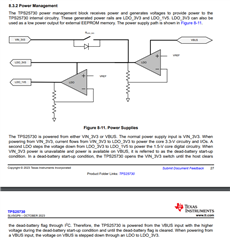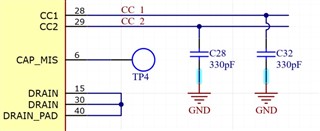Other Parts Discussed in Thread: TPS25730
Chris,
I need this for an application that uses +20V at 2A and USB-C PD sink looks like the correct solution.
Can I please have the Altium files for the TPS25730EVM.
Thank you
Paul
This thread has been locked.
If you have a related question, please click the "Ask a related question" button in the top right corner. The newly created question will be automatically linked to this question.
Chris,
I need this for an application that uses +20V at 2A and USB-C PD sink looks like the correct solution.
Can I please have the Altium files for the TPS25730EVM.
Thank you
Paul
Hi Paul,
Thanks for the information. See the attached zip file.
Understand that these files should only be used as reference.
Thanks and Regards,
Chris
Chris,
Thank you for the files. I was looking closely, and the Altium project uses TPS25730DRJKR that has pin 36 as "Fault_Out". The datasheet has pin 36 as "reserved". Also, the part number in the datasheet is TPS25730DREFR, and this is the part number that is orderable from the website.
What do I do with pin 36 on the TPS25730DREFR device?
Thank you
Paul
Hi Paul,
You should follow the datasheet recommendation.

Thanks for pointing that out, we will on updating the EVM.
Thanks and Regards,
Chris
Thank you Chris,
One LAST question. VIN_3V3, Pin 38: If I do not connect anything to that pin, I think the part assumes "Dead Battery" when the USB-C connector is connected. If in "Dead Battery" mode, the part looks at the ADCIN(1:4) pins and does the PD power negotiation based on the pins alone correct? Am I thinking about this correctly? Is there any major issue with not connecting VIN_3V3?
Paul
Hi Paul,
The TPS25730 can either be powered from VBUS (Dead Battery) or from some internal power supply by VIN3V3 (not Dead Battery). Once power is received from either option, the part looks at the ADCIN pins and does the PD power negotiation based off the pins alone. For any compliant USB-C contract, the initial "communication" happens through resistive dividers and voltage sensing on the CC lines. An implicit 5-V contract is "negotiated" through this divider and sensing mechanism. Once that initial negotiation happens, the source will provide 5-V on VBUS to the TPS25730. We will then boot in dead battery mode and look at the ADCIN pins, and then we will proceed with PD negotiation to negotiate any higher voltage/power contracts.

Is there any major issue with not connecting VIN_3V3?
No issue, just realize that the part will not be on if nothing is connected to the Type-C connector.
Thanks and Regards,
Chris
Chris,
You stated above "An implicit 5-V contract is "negotiated" through this divider and sensing mechanism".
Do I need to provide that resistor divider externally or are the resistors inside the part of this "negotiation"?
I plan on connecting the CC lines directly to the USB-C connector with the caps and a TPD4E02B04DQAR TVS.
Is this "ok"?

Hi Paul
You stated above "An implicit 5-V contract is "negotiated" through this divider and sensing mechanism".
Do I need to provide that resistor divider externally or are the resistors inside the part of this "negotiation"?
The TPS25730 handles the dividers on the CC lines. You do not need to provide the dividers.
I plan on connecting the CC lines directly to the USB-C connector with the caps and a TPD4E02B04DQAR TVS.
Is this "ok"?
Yeah, that is ok.
Thanks and Regards,
Chris